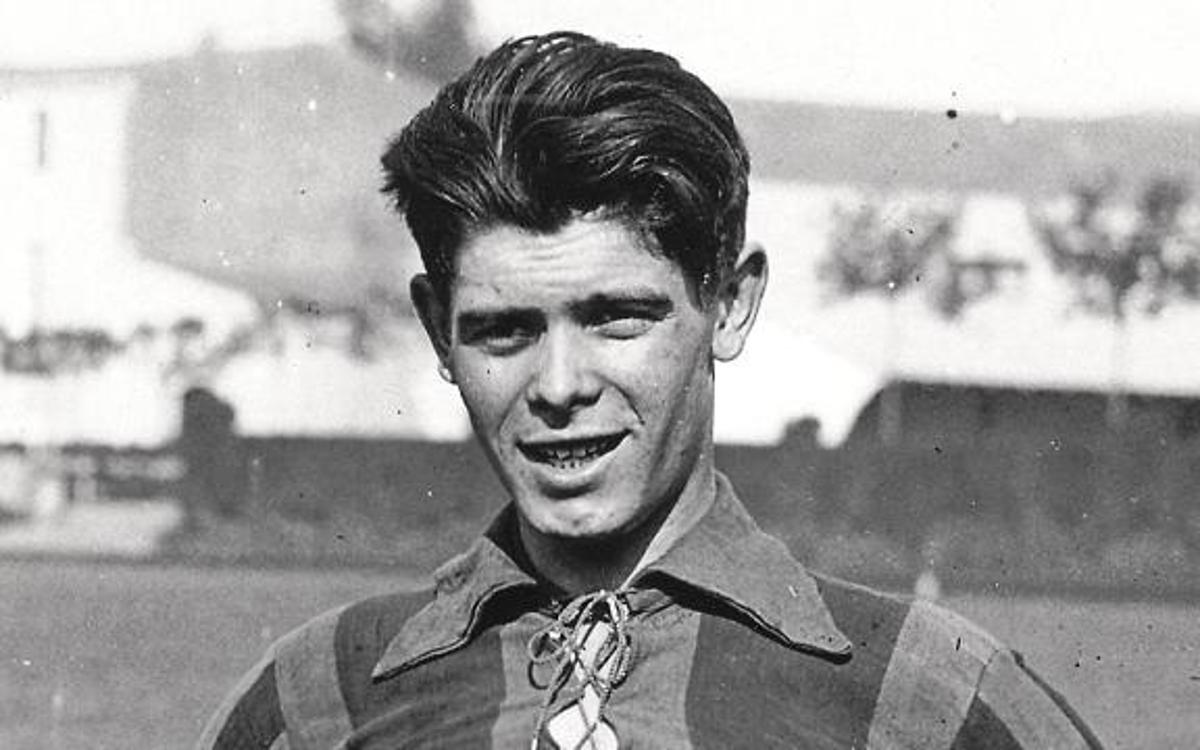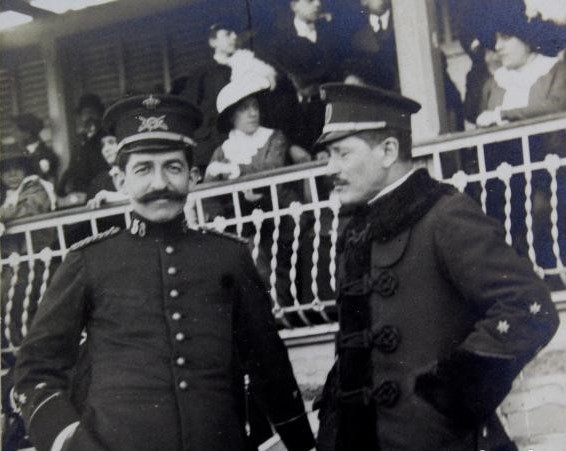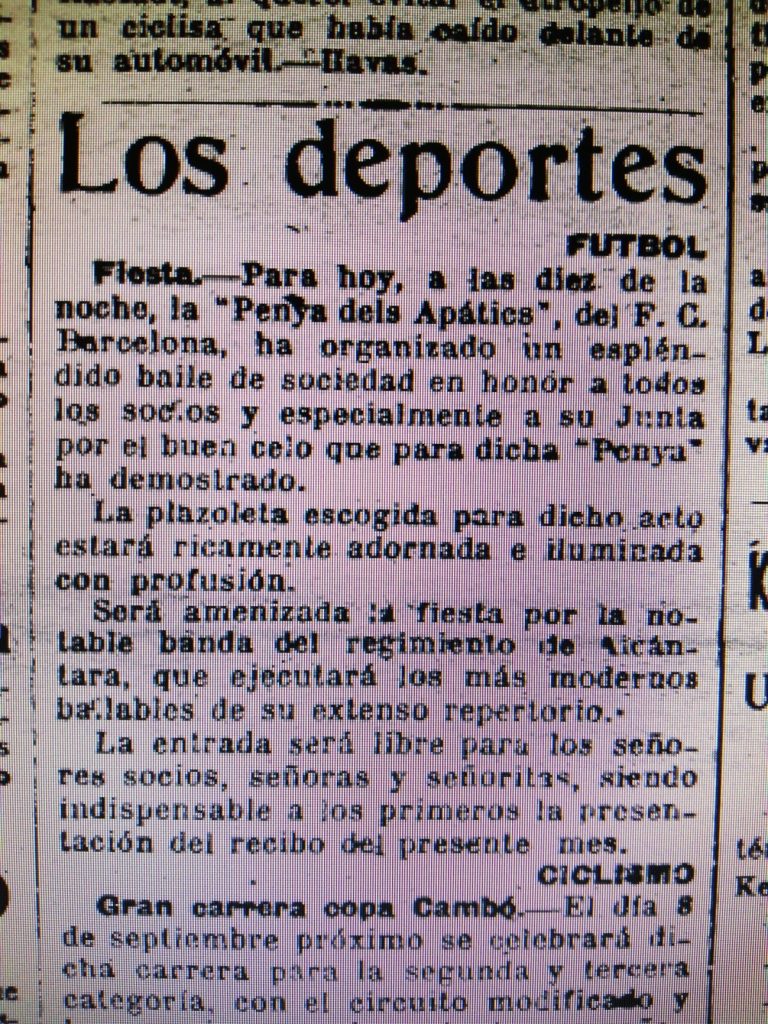If we analyse some of the events of the second decade of FC Barcelona’s twentieth century, we could come to the conclusion that there is a certain relationship between the appearance of the supporters’ clubs and the first political division in Barcelona, which has lasted until the present day. And that is when we ask ourselves: what kind of relationship can link a world of unity and consensus, such as that of the supporters’ clubs, with an event that represents such division within the Club as the famous “isms”?
If we go back in time, it all began on 17 July 1910, when FC Barcelona decided to celebrate the achievement of the 1909/1910 season treble (Catalan Championship, Spanish Championship – now known as Copa del Rey – and the Challenge International du Sud de France or Pyrenees Cup) in its new small stadium in Industria Street. For the first time, this celebration included the performance of the Club’s first anthem, which can also be considered the first anthem of a European football team. Composed by the Galician military man José Antonio Lodeiro Piñeiroa, this anthem had very combative lyrics and joyful music performed by the band of the Regiment of Alcántara 58 infantry, a military regiment located in Barcelona. Among the members of FC Barcelona, there were military men who shared victories and successes with members of the Catalan bourgeois class, such as General Juan Avilés or the Peris de Vargas family, which had many brothers, three of whom came to wear the blaugrana shirt. Enrique Peris, who played 308 games for Barça from the 1906/1907 to the 1916/1917 season, is worth mentioning.
Among the Peris brothers, there was one who was not a player, but who has gone down in history as one of the most controversial leaders during his time as president of FC Barcelona, on two occasions, until the summer of 1915. On 29 June 1915, Rafael Llopart became president, and a year later, on 25 June 1916, he was succeeded by the Catalan nationalist politician Gaspar Rosés, who clearly won the elections against Peris de Vargas’ man, Josep Preckler. The club calmed down, although externally there were several problems with the federations. But the remedy to everything was always Joan Gamper, and so, in the elections of 17 June 1917, he returned to the presidency for the third time and remained in charge until 19 June 1919, when he was replaced by his colleague Ricard Graells.
And what do the Barça supporters’ clubs have to do with all this?
Peris de Vargas or his followers were not quiet during the following years, and whenever there was an obstacle in the successive directives, they appeared to demonstrate their opposition. It is also in 1915 that there is the first reference in FC Barcelona’s fourth teams, where we can see the division between the two political groups within the club: the monarchists and the Catalanists. It is not known exactly when the so-called fourth teams actually appeared or what they consisted of. Some say that they were the children’s teams (because the B and C teams already existed), others think that they were actually more diverse teams or, in other words, supporters’ teams.
In our opinion, always debatable, they were teams of young people without any age range who organised their own tournaments or friendly games. In other words, nothing to do with today’s structure in the grassroots categories of football.
References of the fourth teams
- 1915: Hutchinson (first mention in Foot-Ball magazine, 3/6/1915), Matas (3/6/1915).
- 1916: Cuarto G (22/6/1916), Águilas (24/8/1916), New Hudson (28/9/1916), Reina Victoria Eugenia (3/11/1916). The latter team appeared just after the first Catalanist political president, Gaspar Rosés, became president. Coincidence?
- 1917: Vampiros (1/2/1917), 70 HP (12/4/1917), H (28/6/1917), TBO (27/7/1917), Novells (11/10/1917), Thedy (20/12/1917).
- 1918: Tranquils (7/3/1918), Atiles (21/3/1918), Nova Germanor (11/4/1918), The Tango (13/6/1918), Els Teddys (20/6/1918), Alfonso XIII (27/6/1918), Apàtics (15/8/1918), No’ns Contis (5/9/1918), Aliats (26/9/1918), Los Calaveras (7/11/1918), Retintins (12/12/1918).
In this last list, we should look at the Apàtics, as this fourth team will go a step further and will now classify itself as a penya. It should also be added that Vicenç Piera, the future great player of the Golden Age, known as “La Bruja” and who currently gives his name to the Penya de La Ràpita, came from the Penya Nova Germanor. So, in addition to the Apàtics, there is also another leap from fourth team to “penya” in the case of Nova Germanor, which is even older than the Apàtics. However, the fact that we found the denomination “penya” when Piera joined in 1920 raises doubts as to whether one or the other was first.
- 1919: Els Reposats (20/3/1919), Els Segadors (1/5/1919), Els Amics (1/5/1919), Els Esmolets (15/5/1919), Els Nacionalistes (15/5/1919), Els Únics (15/5/1919), Nacional (26/6/1919), Almogàvers (17/7/1919), Atletes (17/7/1919), Jove Catalunya (4/9/1919).
In 1919, Barça took another step forward on the Catalanist path with the new presidency of Ricard Graells, who a year earlier had supported the request for a Statute of Autonomy for Catalonia and who made the floral offering at the monument to Rafael Casanova on 11 September for the first time in its history. And coincidence or not, it can be seen that in 1919 the names of the fourth teams were mostly Catalanist and some of the previous monarchist names disappeared. Faced with the theory that the fourth teams were children’s teams, we ask ourselves the question: do we honestly believe that a children’s team could be given names like Segadors, Esmolets, Nacionalistes or Almogàvers? And, finally, the fact that Piera joined Nova Germanor at the age of 17 suggests that those teams were not exactly youth teams.
These appearances, which would continue into the 1920s, show that the Club’s social mass had already made an irreversible political turn that, with more or less clandestinity and more or less discomfort, would already form part of a DNA and roots that have lasted into the 21st century.
The Apàtics case
In 1918, one of these fourth teams also made the leap to a new dimension and to the new term of penya. This was the Apàtics: a supporters’ club which, as its name suggests, seemed to be one of those who did not believe too much in the new direction taken by FC Barcelona’s board. As published in the magazine Foot Ball, behind this supporters’ club was the Peris de Vargas family. In fact, Enrique Peris had also left the Club with the entry of Gamper as president in 1917 and with the definitive separation into what we will call “Perists” and “Gamperists”. Also coincidence? Why do we believe that behind this supporters’ club was Mr. Peris de Vargas or his followers? Simply because of the only publication we found of a penya activity.
It is about a Saint James festival dance in a small square in Barcelona. Apparently, there would be no suspicion of the presence of groups opposed to Gamper behind the Apàtics Barcelonistes, especially since they demanded a paid membership receipt. It does not specify whether this fee was the Club’s membership fee or that of the supporters’ club itself, but we think it was the former because it was then conceivable that those who did not pay the fee ceased to be members and, therefore, ceased to be elements to whom an electoral campaign could be directed. We recall that at that time there were elections every year, as can be read in the Statutes.
However, the suspicion arises when we see that the band that would liven up the dance is the music band of the Alcántara Regiment; that of Peris de Vargas, that of Lodeiro Piñeiros. It is the military band that composed the Club’s first anthem eight years earlier. Faced with this mysterious announcement, and in search of a second piece of information, we can only move on to the following year, when the first FC Barcelona supporters’ club became official: Penya Barcelonista del FC Barcelona. But that is a different story.
So, considering the little information we have from those years, right now and without any new evidence to the contrary, we can consider Nova Germanor as the first sports supporters’ club of FC Barcelona, and the Apàtics as the first unofficial social supporters’ club.








